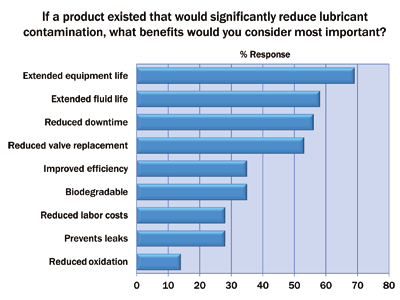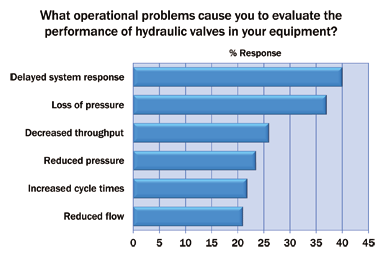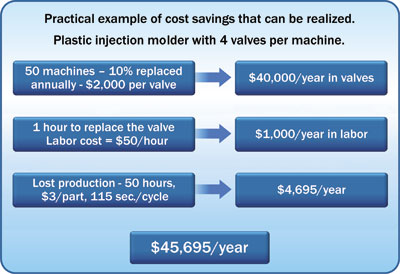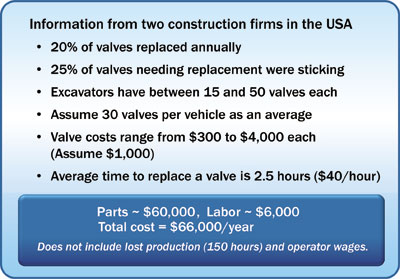Clean Solutions for Hydraulic Oil Technology Needs
Hydraulic equipment owners and operators expect superior performance from their investment. When it comes to their business, they are looking for the three “E”s: economy, efficiency and environment. As regulatory requirements increase and equipment design changes, hydraulic oil technology must continue to evolve to keep pace.
Developing the right additive technology to meet the industry’s changing needs requires additive suppliers to take into account all the variables — from the expectations for modern equipment and fluids to the possible results of poor oil performance. By obtaining an accurate picture of the hydraulic equipment landscape, additive formulators can deliver the right solutions.
Expectations
 Today’s hydraulic machinery works hard. It is expected to be highly reliable with minimum downtime and cost effective operation. The expectation of a safe working environment also dictates that hydraulic systems operate with low equipment noise. Perhaps the most important expectation is efficiency. Hydraulic systems are expected to deliver responsive and precise movement with maximum efficiency. When valves become stuck or are unable to respond immediately to commands, they can have an impact on operational efficiency and result in costly repairs.
Today’s hydraulic machinery works hard. It is expected to be highly reliable with minimum downtime and cost effective operation. The expectation of a safe working environment also dictates that hydraulic systems operate with low equipment noise. Perhaps the most important expectation is efficiency. Hydraulic systems are expected to deliver responsive and precise movement with maximum efficiency. When valves become stuck or are unable to respond immediately to commands, they can have an impact on operational efficiency and result in costly repairs.
As the expectations on hydraulic equipment increase, so do the demands on the hydraulic fluid. Hydraulic fluids are expected to protect the entire system while transferring fluid power efficiently, even as systems become more compact and encounter harsher environments with extreme temperatures. Despite these increased performance requirements, hydraulic fluids are required to last longer while still being cost effective.
Equipment Conditions
 Long considered the workhorse of manufacturing and construction, hydraulic equipment is trusted with delivering the power that moves industry forward. Today, the stakes are high and getting higher. In response to new regulations and the drive for improved efficiency and economy, equipment is changing in ways that have not been seen for decades. For example, the hydraulic system pressure and hydraulic pump power-to weight ratio continue to increase. Under these conditions, oil temperatures can reach 115 degrees C at the extreme. Other equipment modifications that will have a significant impact on hydraulic fluids include:
Long considered the workhorse of manufacturing and construction, hydraulic equipment is trusted with delivering the power that moves industry forward. Today, the stakes are high and getting higher. In response to new regulations and the drive for improved efficiency and economy, equipment is changing in ways that have not been seen for decades. For example, the hydraulic system pressure and hydraulic pump power-to weight ratio continue to increase. Under these conditions, oil temperatures can reach 115 degrees C at the extreme. Other equipment modifications that will have a significant impact on hydraulic fluids include:
- Servo-electric motors to improve hydraulic system efficiency
- Increased hydraulic oil tank turnover
- Minimized hydraulic system fill volumes
- Closed-loop hydraulic systems
Oil Conditions
As is the case with hydraulic equipment, hydraulic oils are also seeing tougher conditions. Higher temperatures are a given, as are higher oil pressures and shear rates. The fluid works much harder and much hotter as it cycles rapidly through the reservoir with less time to cool, release heat and disperse foam. The end result is a tendency to create materials within the system that can cause varnish, ultimately leading to valve sticking.
End-User Research
Of course, knowing the issues isn’t enough. Only by talking with end users can real needs and problems be identified. A recent survey of end users found three key needs regarding hydraulic fluids: productivity, extended equipment life and reduced downtime. The survey also enabled the identification of the top operational problems end users were experiencing with hydraulic valves. This was further explored to determine which benefits end users considered most important.
Survey participants included representatives from a number of industries including plastics, government, construction, general manufacturing, waste disposal, civil engineering, specialty production, agriculture, forestry, marine, and oil and gas.
The research revealed that the cost of valve replacement, which is the response to varnish formation, is an important issue for end users. Hydraulic equipment operators, like everyone else, are concerned about economy. In many cases, slow or failed valve actuation means valves are routinely changed or cleaned, which costs time and money. Failure to respond to valve sticking can result in:
- Decreased production (most operators only respond when slow actuation is obvious)
- Unscheduled downtime
- Increased costs
- Safety concerns
Effects (Varnish)
 Varnish occurs as oil ages. In addition to the natural process of additive consumption, hydraulic fluid degrades as a result of oxidation and thermal decomposition. The ideal solution is a hydraulic fluid that does not deposit varnish on surfaces. This would lessen or eliminate the need for valve replacement. Reducing valve sticking not only would improve the operational economics but also help the environment by maintaining operational efficiency and maximizing the use of power.
Varnish occurs as oil ages. In addition to the natural process of additive consumption, hydraulic fluid degrades as a result of oxidation and thermal decomposition. The ideal solution is a hydraulic fluid that does not deposit varnish on surfaces. This would lessen or eliminate the need for valve replacement. Reducing valve sticking not only would improve the operational economics but also help the environment by maintaining operational efficiency and maximizing the use of power.
Following are a few real-world examples of how additive technology that prevents varnish can deliver real cost savings.
Plastic Injection Molding
Plastic injection molding is a very common method of mass-producing parts, so when valves stick and hydraulic systems need to be shut down for unscheduled maintenance, there are several impacts on the company’s financial bottom line. In the example above, a plastic injection-molding company with 50 machines (four valves per machine) saw potential savings of $45,695 per year with the right hydraulic oil.
Gas Turbine Power Generation
Peaking turbines, which supply power only when demand is high, are another good example of how the right fluid can deliver a better economic result. The presence of varnish can lead to a turbine trip, which means the turbine will not deliver power when needed. The potential cost of a turbine trip can be $5,000 to $120,000.
Off-Highway Excavators
 In the construction industry, pulling a piece of equipment out of service to change hydraulic valves can mean a significant loss of time and money. For instance, information from two construction firms showed a total possible cost of $66,000 per year for a 40-excavator fleet resulting from valve replacement.
In the construction industry, pulling a piece of equipment out of service to change hydraulic valves can mean a significant loss of time and money. For instance, information from two construction firms showed a total possible cost of $66,000 per year for a 40-excavator fleet resulting from valve replacement.
As these examples indicate, the cost of varnish can be high. Reduced efficiency can sometimes go undetected, and by the time this becomes obvious to the user, a significant amount of additional energy may have been consumed with the consequential impact on the environment.
Additive Solutions
Because hydraulic formulations are carefully balanced to meet original equipment manufacturer requirements, adding a new varnish-mitigating feature to the fluid’s performance profile requires a unique solution. Fortunately, fluids are now available incorporating additive chemistry that reacts with the precursors to varnish, minimizing the formation of resinous films on system hardware. This clean technology will be a must-have for all industrial fluids.
There are also additive systems that can remove varnish once it forms. Both of these options allow equipment owners and operators to optimize their systems to best achieve the three “E”s: economy, efficiency and environment.
